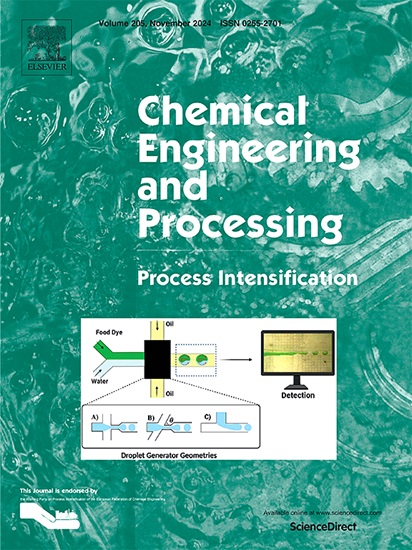Numerical simulation of structured surface roughness effects on flow boiling characteristics in microchannel
IF 3.8
3区 工程技术
Q3 ENERGY & FUELS
Chemical Engineering and Processing - Process Intensification
Pub Date : 2025-07-06
DOI:10.1016/j.cep.2025.110439
引用次数: 0
Abstract
Effects of structured roughness shape and size on flow boiling heat transfer in microchannels are numerically investigated with the Volume of Fluid (VOF) method and the Lee model. Rh is proposed to characterize the area-averaged height of 3D roughness. First, roughness shapes of triangular pyramid, cube, and hemisphere are compared by assessing the Nusselt (Nu) and Poiseuille (fRe) numbers. Then, the base edge length a and height h of the triangular pyramid roughness elements are varied to examine their effects on flow boiling. The results indicate that microchannels with triangular pyramid roughness exhibit the best heat transfer performance among the three shapes. Furthermore, increasing either a or h of the triangular pyramid roughness elements can enhance the thermal-performance of the rough microchannels. Additionally, Nu increases by 1.64 % when a is raised by 25 %, while increasing h by 25 % results in a 4.45 % increase in Nu. Similar scenario occurs for fRe. This indicates that h rather than a has greater effects on the microchannel flow boiling. However, the effect of Rh on Nu and fRe exhibits complexity due to the shape dependence.

结构表面粗糙度对微通道流动沸腾特性影响的数值模拟
采用流体体积法(VOF)和Lee模型对结构粗糙度形状和尺寸对微通道内流动沸腾换热的影响进行了数值研究。提出了Rh来表征三维粗糙度的面积平均高度。首先,通过努塞尔数(Nu)和泊泽维尔数(fRe)比较了三角形、金字塔、立方体和半球的粗糙度形状。然后,改变三角金字塔粗糙度单元的底边长度a和高度h,考察它们对流动沸腾的影响。结果表明,三种形状的微通道中,具有三角棱锥粗糙度的微通道传热性能最好。此外,增加三角金字塔粗糙度单元的a或h都可以提高粗糙微通道的热性能。此外,当a增加25%时,Nu增加1.64%,而当h增加25%时,Nu增加4.45%。类似的情况也发生在fRe中。这表明h比a对微通道流动沸腾的影响更大。然而,由于形状依赖,Rh对Nu和fRe的影响表现出复杂性。
本文章由计算机程序翻译,如有差异,请以英文原文为准。
求助全文
约1分钟内获得全文
求助全文
来源期刊
CiteScore
7.80
自引率
9.30%
发文量
408
审稿时长
49 days
期刊介绍:
Chemical Engineering and Processing: Process Intensification is intended for practicing researchers in industry and academia, working in the field of Process Engineering and related to the subject of Process Intensification.Articles published in the Journal demonstrate how novel discoveries, developments and theories in the field of Process Engineering and in particular Process Intensification may be used for analysis and design of innovative equipment and processing methods with substantially improved sustainability, efficiency and environmental performance.

 求助内容:
求助内容: 应助结果提醒方式:
应助结果提醒方式:


